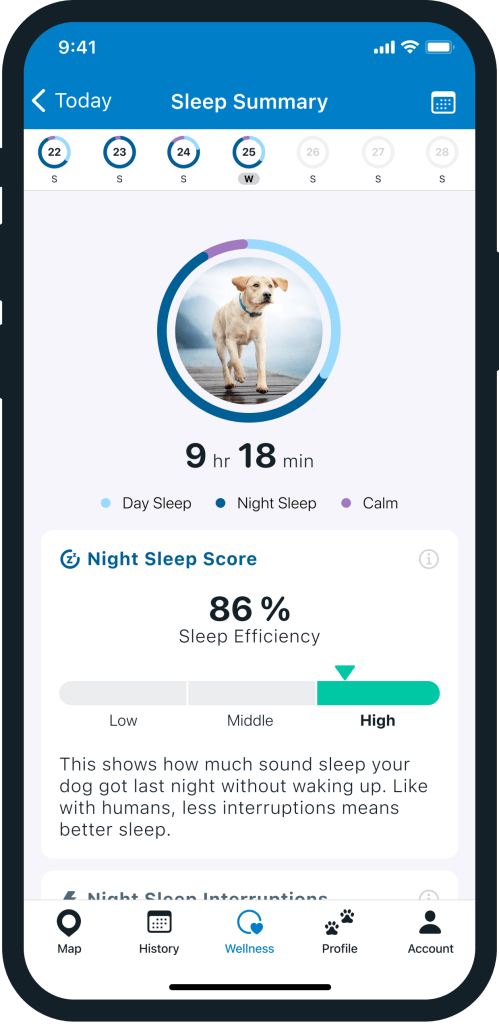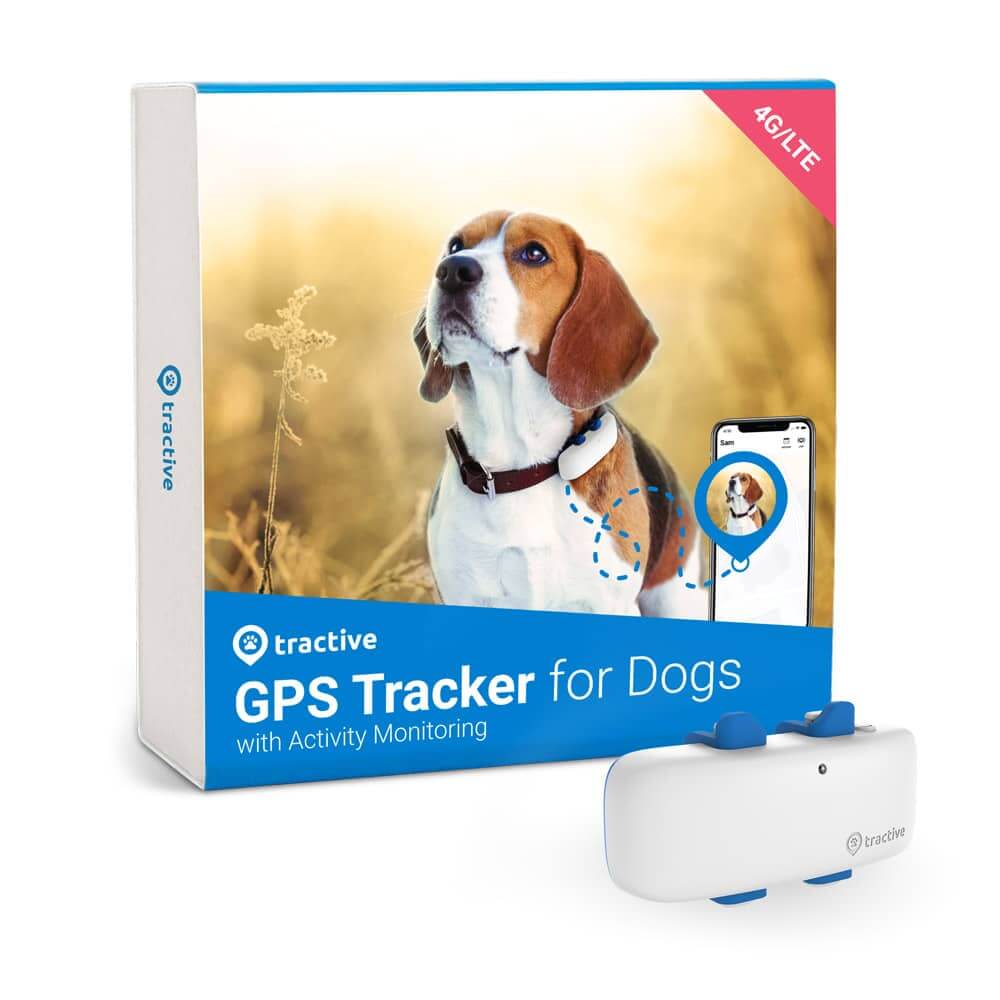 Approved by Dr. Dwight Alleyne, DVM
Approved by Dr. Dwight Alleyne, DVM Is My Dog Sick? The Main Signs Of Illness In Dogs
Is your dog acting funny? Moving less? Sleeping more? It might be time to talk to your vet. Read on to learn about signs of illness in dogs & what signs can help you get them to a vet early.

Is my dog sick? That’s a question our dogs (sadly) can’t answer for us. And since they’re good at hiding what’s bothering them in the early stages of sickness or disease, it can be easy to miss the signs of illness in dogs. (Until it’s too late and now you’re dealing with a hefty vet bill…or worse.)
But you know your furry friend like no one else and can sense if things are not quite right. So in this guide, we’ll talk about what signs of illness in dogs to look for – and how a drop in their activity can be one of the first red flags to look out for.

Find out how your dog spends their time.
Read moreIs my dog sick? How can I tell?
The first thing to do is check if your pup is acting like their usual self. Because much like us humans, dogs tend to act differently if something is wrong with them. For example, your dog might seem:
- Less interested in food,
- Reluctant to participate during playtime
- Tired from not sleeping well enough – or sleeping too much
- Or be less active in general.
🚩 A drop in your dog’s regular activity is usually the first red flag that something’s not right. That’s why vets recommend you:

“Keep track of your dog’s energy levels, especially how long they are able to walk.
If you notice significant declines, it could be a sign of pain, heart disease, or other illness.”
– VCA Animal Hospitals1
With an Activity Tracker for dogs, you can spot a drop in your dog’s daily activity and energy levels quicker and easier – so you can get them to a vet earlier. (Which we’ll cover a little further below.)
Symptoms & signs of illness in dogs
Dog sickness can occur for a whole number of reasons, ranging from the harmless (like when a dog eats grass) to serious (like rabies or cancer). Their symptoms depend on the type and cause of the illness.
The following list of signs of illness in dogs explains the most common warning signals that you have a sick dog and they may need veterinary care.
Lethargy
Pay attention to how much your dog normally moves. Any significant change in your dog’s usual level of activity could signal that something’s wrong. Dogs in pain will typically be less active than healthy dogs – like with senior dogs, who are vulnerable to mobility-affecting conditions, like arthritis. So if your once-active dog now seems to be in a slump, get in touch with your vet for an early checkup.
Read more: Arthritis In Dogs: How To Deal With Hip And Joint Problems In Dogs
Sleep disturbances
Many sick dogs will sleep more than usual, but have worse sleep quality. Pain and discomfort can get in the way of a good night’s sleep. But since dogs tend to be super sleepers, it’s easy to miss out on a change in their sleep patterns. (I.e., whether they’re sleeping more or less – or worse.)
That’s why vets say that unusual changes in your dog’s sleep may be cause for concern.1 If you notice your dog is suddenly sleeping more throughout the day, they may be sick.

“If your dog usually sleeps for 2-3 hours in the morning and then is up for the rest of the day – but then you suddenly notice they are sleeping for 5-6 hours in the morning and into the afternoon, it’s time to call the vet.”
– PetMD
Vomiting
If you notice your dog vomiting, this is a clear sign your dog is sick or at least has an upset stomach. Vomiting and diarrhea are often the most common first signs of illness. If your dog throws up once but otherwise acts normally, the issue may not be so serious. However, vomiting can also be a sign of a more serious illness.
Keep an eye on your dog and call your vet if they vomit several times within one day, vomit blood, or seem lethargic or weaker than usual. It could be caused by:
- Infectious diseases
- Food allergies and sensitivities
- Bowel disease
- Metabolic diseases
- Eating something toxic
- Cancer
- Intestinal obstruction
- Parasites
- Stomach bloat
- Parvovirus
- Kidney or liver failure
- Addison’s disease
- Pancreatitis2
Read more: Toxic To Dogs: Dog Parents Beware Of These Common Dog Poisons
Diarrhea
Diarrhea is another common symptom of sickness in dogs, and it refers to runny, frequent and fluid poo. Normal healthy dog poop is firm, brown and log-shaped. If you notice your dog’s stool is unusually wet or runny, your dog likely has diarrhea. Most likely due to:
- Food intolerance
- Stress
- Spoiled foods
- Poisoning
- Allergies
- Infection
- Parasites
- Overeating
- Disease,
- and medications
Read more: Diarrhea In Dogs: Top Causes And Treatments
Loss of appetite
Most dogs look forward to meal-time and love being fed their favorite treats. Or, they’ll eat anything they can get their paws on. So if you suddenly notice your dog not eating, or gradually losing interest in food over time, this is a strong indicator your dog may be sick.
Note: It’s normal for dogs to eat less in warm weather when they may be less active due to high temperatures. Also, senior dogs don’t need as many calories as adult dogs.
If your dog isn’t finishing their daily meals like they usually do, it may be time to seek veterinary support.
Toilet trouble
If your dog starts peeing more often or less often than usual, or seems to have difficulty going, this can be cause for concern. It could signal a variety of illnesses, from urinary tract infections to liver or kidney disease. Get in touch with your vet as soon as possible about urination issues, especially if you notice blood in your dog’s urine.
Drinking too much or too little water
Another sign of illness in dogs is a change in their thirst level or drinking habits. A dog that won’t drink water or drinks too much water might be unwell and dealing with a fever or kidney problems.
Read more:
- 5 Reasons Your Dog Won’t Drink Water & What To Do
- 12 Reasons You’ve Got A Dog Drinking A Lot Of Water
Unexplained weight loss or weight gain
Unexplained weight gain or weight loss is another sign of illness in dogs. You can use a body condition score for dogs (and a dog BMI calculator) to see if your canine friend’s weight is within the healthy range. If your dog starts to look skinnier than usual, or if they’ve put on a few pounds recently, talk to your vet to find the underlying cause.
Read more:
Behavioral changes
Sudden behavioral changes in your dog – such as aggression, biting, or being extra protective of parts of their body – are also a cause for concern.
- For example, biting and aggression can be symptoms of rabies in dogs.
- Or a grass awn wound may cause your dog to suddenly act differently due to pain where it got in.
In any case, if your dog is suddenly not acting like themselves, speak to your vet.
Trouble walking
If you’re noticing your dog having difficulties walking, getting up, or getting around, it could be:
- Joint problems
- Hip dysplasia
- Arthritis
- A broken bone
- Infections
- Or another illness
In some cases, your buddy might just need a bit of rest to return to normal. (Especially if they seem lame or stiff.) But if the issues persist or you spot other symptoms, see your vet.
Difficulty breathing
Dogs who are experiencing labored breathing might also experience coughing, wheezing, gagging, or shortness of breath. These symptoms are not normal for dogs and could be a sign of:
- Canine influenza (dog flu)
- Heart failure
- Canine infectious respiratory disease
- Heartworm disease
⚠️ Visit your vet right away if your dog has any respiratory problems, or seems to be struggling to get air.
Sneezing or runny nose
Similarly, sneezing, a runny nose or watery eyes also indicate sickness in dogs. Dogs can catch colds just like us (even Covid-19) so be on the lookout for cold-like symptoms in your furry friends.
Pale or discolored gums
Healthy dog gums should be bubblegum pink, or a similar color. Get familiar with your dog’s gum color when they’re healthy so you can spot when something’s off.
- Pale gums are one of the top signs of illness in dogs and can indicate many illnesses such as dehydration, bloating, or even cancer.
- Purple, yellow, blue or bright red discoloration of dog gums also mean that your dog is probably not feeling well and that you should speak to a vet.
Read more: Dog Dental Care: How To Get Your Dog The Best Smile Ever
Fever
Sick dogs can also come down with a fever. Use a digital thermometer to check your dog’s temperature. The normal temperature for a dog’s body is between 101 and 102.5ºF3.
Fever in dogs can be caused by:
- Poisoning
- Bacterial, viral or fungal infection
- Ear infection
- Infected bite or wound
- Tooth or mouth infections
- Urinary tract infection
- Immune system disorders
- Cancer
If your dog’s temperature exceeds 103°F, try to cool them down using a fan, or by applying a towel or cloth soaked in cool water. Continue monitoring their temperature. If their temperature goes up or passes 106°F, take your dog to an emergency veterinary clinic or animal hospital.
⚠️ Never give your dog human medications – these can be poisonous for them.
Itching, gnawing or hair loss
Another sign of illness in dogs is itching, biting, or gnawing at a certain part of their body. Dogs who itch or gnaw excessively may have fleas, infections or canine allergies.
You should go see your vet about itching in dogs especially if it is accompanied by hair loss, redness, swelling, discharge or an abnormal odor.
Most common dog diseases: Symptoms & treatment
As you can see, there are many possible ways our dogs, like us, can get sick. But luckily, you can prevent your dog from catching a sickness by staying on top of their vaccinations.
Below is a chart of some of the most common dog illnesses and what symptoms you should keep an eye out for before heading to your vet.
| Disease | Symptoms |
|---|---|
| Ear infections | Scratching or pawing at ears, shaking head, redness, scabs, crust or hair loss around ear, balance issues, pain, hearing loss. |
| Distemper* | Pus-like discharge from eyes, fever, loss of appetite, runny nose, lethargy, vomiting, diarrhea, pneumonia, seizures, hardened paw pads. |
| Rabies* | Seizures, aggression, paralysis, lack of coordination |
| Cancer | Lumps, odor, discharge, swelling, sores, weight loss, lethargy, pain, appetite changes |
| Diabetes | Increased thirst and urination, appetite changes, weight loss, lethargy, vomiting |
| Heartworm* | Coughing, difficulty breathing, vomiting, weight loss, fatigue |
| Hepatitis* | Discharge from eyes and nose, congestion, thirst, loss of appetite, fever, yellowish ears, gum and skin, red spots on skin, swelling, seizures |
| Kennel cough* | Dry cough, gagging, fever, phlegm, runny nose |
| Parvovirus* | Vomiting, diarrhea |
| Lyme disease* | Lameness, swollen lymph nodes, fever, joint inflammation, fatigue, loss of appetite |
| Leptospirosis* | Kidney, liver disease Symptoms often go unnoticed |
| Canine obesity | Excess fat; difficulty feeling the ribs cage, lethargy |
| Heat stroke | Elevated temperature, panting, drooling, thirst, weakness, pale gums, vomiting |
*Preventable through vaccinations, deworming and/or preventative medications.
Steps you can take to prevent your dog from falling sick
Besides monitoring your dog’s condition and behavior closely, you should also:
- Wash your hands to prevent the spread of sickness and disease among all your family members, including your dogs.
- Prioritize regular vet checks, at least once a year for a general checkup. Head over as soon as possible if you notice any unusual symptoms or signs of illness.
- Vaccinate (and keep up to date): Make sure your dog has all the necessary vaccinations based on their environment and lifestyle.
- Use flea, tick and parasite prevention: Give your dog vet-recommended medications to protect them against pests and pest-borne illness. Other animals can also carry diseases that can be passed on your dog in case they’re bitten.
- Watch what your dog eats: Dogs often get sick from eating spoiled food, contaminated water or toxic substances.
- Clean up: Regularly clean or tidy up your dog’s environment, such as floors, bedding and toys, to keep it free of harmful objects (like glass, grass awns or splinters), bacteria or parasites.
- Cook meat thoroughly: Raw meat can carry food-borne illnesses, so make sure any meat your dog consumes is cooked thoroughly.4
How an Activity Tracker can help you monitor your dog’s health
Your dog isn’t likely to come complain to you about their symptoms. Rather, all you’ve got are their observable behaviors – like if they seem less active or sleep more than usual. All of which can be understandably difficult to jot down and be constantly vigilant about 24/7.
💡But with the actionable data from an Activity and Sleep Tracker that’s built for dogs, you can catch on to the signs of illness in dogs much before they have a chance to worsen.

With its built-in motion detector, your trusty Tractive GPS both monitors where your dog’s off wandering – but also how often they’ve been on the move. (And
So you can see (in numbers):
- How active your dog is when they’re healthy,
- How much sleep your dog gets on the regular,
- If there’s a weird spike or dip in your dog’s active or sleep minutes – which could signal something’s wrong.
All of which can help you have a more productive conversation with your vet – and catch on to a sickness much in advance (Avoiding a hefty, thoroughly avoidable vet bill.)
Ready to help your buddy live their happiest, healthiest life?
Whatever treatment path you choose, it’s a personal choice to be made by you with the help of your vet, taking into consideration your dog’s unique situation. But with all that said:
💡The most effective way to treat disease in dogs is to prevent it.
- Vaccinating your dog, ideally when they’re young, can help prevent many canine diseases. Your vet can tell you which shots are a good idea, based on where you live and your dog’s lifestyle.
- Staying on top of your dog’s hygiene, diet, and hydration can go a long way.
- Monitoring your dog’s behavior, like their activity and sleep, can help you spot a change in their behavior that much quicker – and get them to a vet that much earlier.
With these steps, plus lots of love and care, you’ll be more likely to keep your dog safe and healthy for years to come.

“Absolutely love this tracker…it gives great insights on (our dogs’) activity and sleep levels.
I’m comforted knowing that if they started acting strangely or the data shifted drastically that we could take them to vet potentially before we would notice something wrong.
Can’t recommend this tracker enough!“
– Eva, US (Source: Trustpilot)

Stay on top of your dog’s wellness
See how they’re doing at a glance with Wellness Score. Set goals. Compare with dogs like yours. Monitor sleep. Detect issues and keep them healthy.
For more information about warning signs that your dog may be sick, check out this video by the Continental Kennel Club:
And if you’ve liked this post, share it with a friend or a loved one – and let’s help build a safer, kinder world for our furry friends together.
Your furry friend’s health and wellbeing means as much as to us as it does to you. So we’ve made it a priority to only share medically-relevant content on our blog.
This post was checked, double-checked, and medically verified by Georgia-based vet, Dr. Dwight Alleyne.

Originally from Long Island, New York, Dr. Alleyne began his career at a no-kill animal shelter before becoming a licensed veterinary technician. He graduated from Cornell University Veterinary College in 2006 and completed an internship at Purdue University.
Now practicing in Georgia, Dr. Alleyne specializes in soft tissue surgery and ultrasounds. He also writes pet health articles on his website, “The Animal Doctor Blog” (www.anmldrblog.com).




